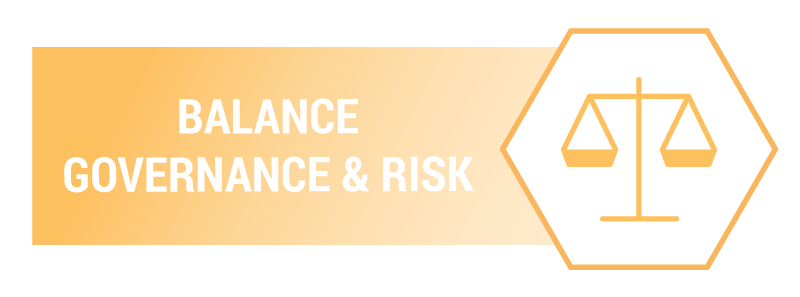Domains of Business Agility
- Responsive Customer-Centricity
- / Fiercely Champion The Customer
- / Sense & Respond Proactively
- / Integrate Diverse Ideas
- Engaged Culture
- / Cultivate A “Learning Organization”
- / Engage Transparently & Courageously
- / Embed Psychological Safety
- / Act As One
- Value-Based Delivery
- / Unleash Workflow Creatively
- / Prioritize. Prioritize. Prioritize.
- / Deliver Value Sooner
- / Seize Emergent Opportunities
- Flexible Operations
- / Adapt Strategies Seamlessly
- / Fund Work Dynamically
- / (Re)Organize Structures Fluidly
- / Balance Governance And Risk
- People-First Leadership
- / Foster Authentic Relationships
- / Empower With Accountability
- / Realize People’s Potential
Balancing governance and risk is among the most challenging yet important business agility capabilities organizations need to strive toward. It means giving people the greatest possible autonomy to serve customers without putting the organization at excessive risk or causing negative repercussions — and it often means challenging your own assumptions about what’s possible. Are you layering mandates? Are you building systems for the lowest common violator? Are you spending $5 to save $1? Are you creating unnecessary delays and bottlenecks? Are people working around the system to get work done?
Good systems help people get things done faster. Organizations should take care of themselves by establishing policies and systems for auditing, governing, and pricing. But these systems must not by default interfere with or block customer relationships or the empowerment of teams. If they do, you have taken them too far. Cultivating business agility means removing the obstacles that prevent your organization from giving customers what they need instead of overly focusing on what employees are (or are not) permitted to do.
Primary Behaviors
The following 6 behaviors strongly contribute to the ability to balance governance and risk.
B63: Leaders remove superfluous controls and approvals: Leaders ensure that business controls and approvals have a clear purpose and value. Any obsolete, duplicate, or unnecessarily complicated governance is regularly archived or streamlined, as appropriate.
B64: Leaders design governance controls that are not one-size-fits-all: The degree of governance specified for a business process is appropriate for the level of potential business risk or impact. For example, all purchase approvals, regardless of amount, may not require the same level of sign-off. If an inappropriate approval is made, leaders provide timely feedback so that the approver is able to make better decisions in the future.
B65: Leaders recognize organizational tensions and make appropriate tradeoffs: Not all challenges in an organization have a simple solution. Some challenges are paradoxes or dilemmas where progress in one direction comes at the expense of another. Leaders can identify situations where such conflicting interests exist and can purposely tradeoff the impact of pursuing one course of action versus another.
B66: Leaders create processes that are fit for purpose and suitable to the level of complexity, risk, and impact: Processes should help an organization run more consistently (versus ad hoc operations). When creating a new process, leaders ensure that it produces the desired outcomes as effectively as possible. The “cost” or overhead of the process (versus the desired outcome) is designed so that it is not overly complicated, risky or ineffectual.
B67: Leaders create and manage contracts to expect change rather than to minimize or control it: Leaders see contracts as an opportunity for the involved parties to clarify and align expectations. Knowing that change will likely be needed during the life of the contract, leaders work to ensure that contractual language includes how change will be communicated, decided and handled, rather than striving to define and “lock down” everything in the contract.
B68: Leaders compensate, reward, and recognize individuals and teams fairly for the work they do: Leaders design and improve the compensation, reward, and recognition programs based on outcomes produced and are consistent and equitable for all individuals and teams in the organization.


